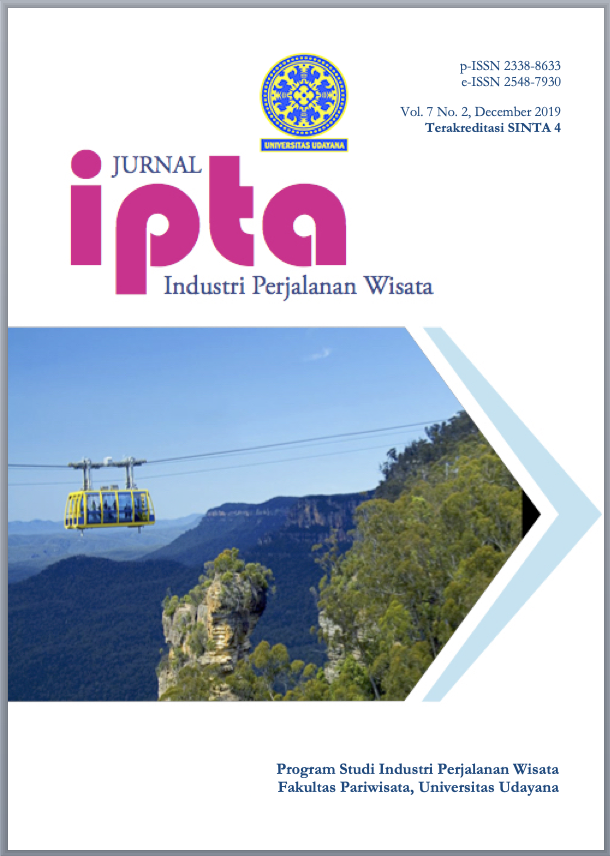TOURISM IMAGE RECOVERY STRATEGY POST-NATURAL DISASTERS IN INDONESIA
Abstract
Tourism potential in Indonesia is a privilege that must be thankful for. However, that potential is not supported enough by the stability of the natural condition itself. Tourists destinations which is popular in Indonesia tend to be liable to the natural disasters. It happens recently in Bali and Lombok. A couple of natural disasters that afflict those two regions as the Indonesian tourism sector has an impact on reducing the number of foreign tourist to visit those tourists destinations. Based on the previous research studies, handling the natural disasters that occur in tourists destinations which are usually being visited by foreign tourist is a way more complex than the similar disasters which occur in the destinations that are only being visited by local tourists. The natural disasters which is involving foreign tousists will also have an impact on the bilateral relations between the two countries. In addition, the foreign media news wil have a wider impact on Indonesia’s image because of dealing with the natural disasters and the responsibilities to the victims. The government is still find some obstacles in dealing with a decreasing reputation after the natural disasters in Indonesia’s tourists destinations, even though the rapid response is correlated with the large amoun of costs that incurred to deal with the disasters. Then, formulating the right strategy for handling the post-natural disasters in Indonesia’s tourists destinations is important. This study aims to find the communication strategies which are needed to be the respons of the natural disasters that occur Indonesian tourism sector. Using the post-positivistic paradigm, this study was approached qualitatively and presented descriptively to reveal the right communication strategy on handling the Indonesia’s tourism sector which is affected by the natural disasters based on the situasional crisis communication theory. The interview was chosen as a data collection technique for the related sector. Open coding, axial coding, and selective coding was used as the data analysis technique. This research is expected to formulate the strategies for restoring the image of Indonesia’s tourism sector after the natural disasters. In fact, the research at this phase is still rarely done becuse the other similar research is still focus on the countermeasures during the disasters such as victim evacuation or the mitigation of the disasters.
Downloads
References
Aji YK Putra. (2018, Agustus 8). Wisatawan Asing Batal ke Lombok, Indonesia Rugi Rp 1,4 Triliun. Retrieved Agustus 9, 2018, from Kompas: https://regional.kompas.com/read/2018/08/08/20094311/wisatawan-asing-batal-ke-lombok-indonesia-rugi-rp-14-triliun.%20diakses%209%20Agustus%202018
Coombs, W. T. (2007). Protecting Organization Reputations During a Crisis: The Development and Application of Situational Crisis Communication Theory. Cooperate Reputation Review, 163-176.
Coombs, W. T. & Sherry J. Holladay. (2010). The Handbook of Crisis Communication. Oxford: Blackwell Publishing.
Coombs, W. T. (2011). Impact of Past Crisis on Current Crisis Communication: Insights from Situational Crisis Communication Theory. Journal of Business Communication, 265-289.
Danu Damarjati. (2018, Agustus 8). Gubernur NTB Terpilih: 381 Orang Tewas Akibat Gempa. Retrieved Agustus 24, 2018, from Detik: https://news.detik.com/berita/d-4156921/gubernur-ntb-terpilih-381-orang-tewas-akibat-gempa
Denzin, N. K., dan Yvonna S. Lincoln. (2000). Handbook of Qualitative Research. California: Sage Publication. Pvt. Ltd.
Gunung Agung Erupsi, Warga Sempat Panik Lihat Asap Hitam Membumbung dari Kawah. (2017, November 21). Retrieved Agustus 9, 2018, from BBC: https://www.bbc.com/indonesia/indonesia-42066104
Gunung Agung Erupsi, Warga Sempat Panik Lihat Asap Hitam Membumbung dari Kawah. (2017, November 21). Retrieved Agustus 9, 2018, from BBC: https://www.bbc.com/indonesia/indonesia-42066104
Aji YK Putra. (2018, Agustus 8). Pasca-gempa Lombok, Menpar Sebut 6.000 Wisatawan Asing Dievakuasi. Retrieved Agustus 9, 2018, from Kompas: https://regional.kompas.com/read/2018/08/08/18085491/pasca-gempa-lombok-menpar-sebut-6000-wisatawan-asing-dievakuasi%20diakses%209%20Agustus%202018
Aji YK Putra. (2018, Agustus 8). Wisatawan Asing Batal ke Lombok, Indonesia Rugi Rp 1,4 Triliun. Retrieved Agustus 9, 2018, from Kompas: https://regional.kompas.com/read/2018/08/08/20094311/wisatawan-asing-batal-ke-lombok-indonesia-rugi-rp-14-triliun.%20diakses%209%20Agustus%202018
Danu Damarjati. (2018, Agustus 8). Gubernur NTB Terpilih: 381 Orang Tewas Akibat Gempa. Retrieved Agustus 24, 2018, from Detik: https://news.detik.com/berita/d-4156921/gubernur-ntb-terpilih-381-orang-tewas-akibat-gempa
Kementrian Pariwisata. (n.d.). PERKEMBANGAN KUNJUNGAN WISATAWAN MANCANEGARA KE INDONESIA. Retrieved Agustus 9, 2018, from kemenpar.go.id: http://www.kemenpar.go.id/userfiles/Laporan%20Wisman%20Bulan%20Juni%202018%20-%20Klasik.pdf
Kriyantono, R. (2012). Measuring a Company Reputation in a Crisis Situation: An Ethnography Approach on the Situational Crisis Communication Theory. International Journal of Business and Social Science, 214-223.
Kurniasari, N. dan Irwansyah. (2016). Kebijakan Komunikasi Krisis Responsif Sektor Pariwisata Indonesia dalam Mengembalikan Reputasi Pasca-Bencana Alam. Communicology dan Kompetensi Komunikasi. Prosiding The Power of Communication Conference 2016, 527-554.
Kurniasari, N. (2017). Strategi Penanganan Krisis Kepariwisataan dalam Kebijakan Badan Nasional Penanggulangan Bencana (BNPB). Mediator Jurnal Komunikasi, 177-189.
Martens, H.M. (2016). Crisis Management in Tourism – A Literature Based Approach on the Proactive Prediction of a Crisis and the Implementation of Prevent Measures. Athens Journal of TourismI, 89-101.
Neuman, W. L. (2011). Social Research Methods: Qualitative and Quantitative Approaches, 7th edition. Boston: Pearson Education, Inc.
Poerwandari, E. K. (2011). Pendekatan Kualitatif untuk Penelitian Perilaku Manusia. Depok: Lembaga Pengembangan Sarana Pengukuran dan Pendidikan Psikologi (LPSP3).
Robinson Gamar. (2017, Desember 23). Gunung Agung Kembali Meletus, Semburkan Asap Setinggi 2.500 Meter. Retrieved Agustus 9, 2018, from Kompas: https://regional.kompas.com/read/2017/12/23/12052721/gunung-agung-kembali-meletus-semburkan-asap-setinggi-2500-meter
Štefko, R. (2015). Strategic Marketing Communication in Pilgrimage Tourism. Procedia – Social and Behavioral Sciences, 423-430.
Walters, G. (2014). Understanding the Tourist’s Response to Natural Disasater: The Case of the 2011 Queensland Floods. Journal of Vacation Marketing, 1-13.





